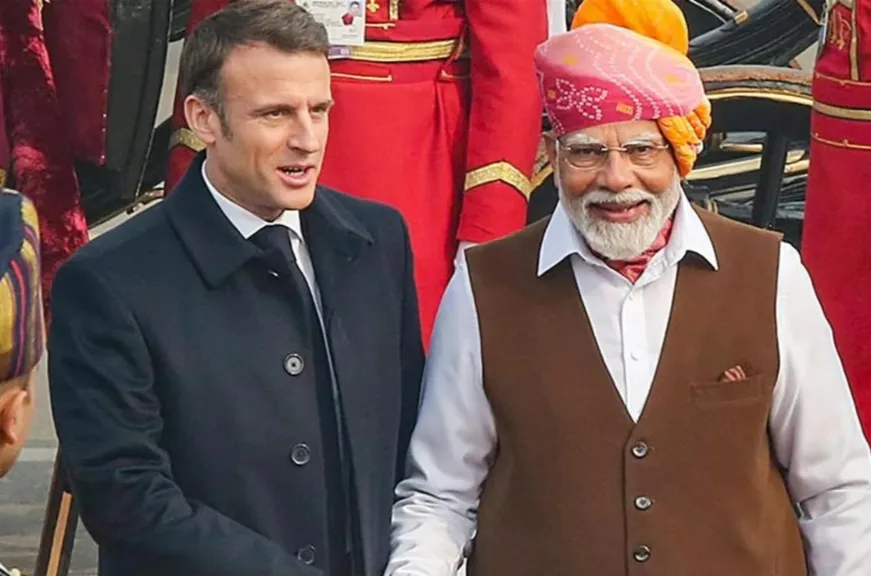In the aftermath of the Russia-Ukraine war in February 2022, several western countries fussed over India’s refusal to explicitly condemn Russia. Simultaneously, French President Emmanuel Macron’s controversial visit to China last year, coupled with his desire to deepen economic ties with Beijing, raised questions about France’s ambiguous policy towards China. Yet despite France’s staunch support for Ukraine and India’s tense ties with China, on neither of these occasions did India and France pressure the other to align positions or take a certain stance.
Both countries’ fierce proclivity towards strategic autonomy in their foreign policies means that potential friction points such as these are removed, paving the way for a special relationship. This is why despite Prime Minister Narendra Modi’s last-minute invitation, President Macron graciously accepted to be the guest of honour at India’s Republic Day celebrations, demonstrating the reliable nature of India’s oldest strategic partnership. As middle and balancing powers, India and France together represent “a third way”, away from United States (US)-China bloc politics.
France is now India’s second largest arms supplier holding 29% of its share as compared to the US, which holds only 11% despite Indo-US ties expanding rapidly.
A multi-faceted partnership spanning cooperation in a range of sectors, defence remains at its core. France is now India’s second largest arms supplier holding 29% of its share as compared to the US, which holds only 11% despite Indo-US ties expanding rapidly. Defence acquisition is a comparatively tedious process in the US compared to France’s more centralised system. Therefore, France is perceived as an easier “fewer strings attached” partner, particularly in the context of India’s goals of diversifying defence needs away from its traditional supplier, Russia, as well as its Make in India initiative that requires technology transfers and advanced know-how for indigenous equipment manufacturing. Besides the mega deals involving Rafale jets and Scorpene submarines, the two leaders adopted a “defence industrial roadmap” aimed at co-development and co-production of military hardware with the potential to also supply equipment to third countries. An Airbus-Tata agreement to manufacture civilian helicopters is in the works.
Yet, security cooperation is not merely limited to arms deals but extends to critical areas such as the Indo-Pacific, where India and France converge on their conceptual definitions of the region and the need to maintain the rule of law and stable sea lanes of communication against an assertive China. This has created the foundations for strong maritime cooperation in security areas including illegal fishing and anti-piracy as well as enabled trilaterals with “like-minded” nations such as Australia and the United Arab Emirates.
Both India and France are resident powers. France has citizens, military bases, territories, and economic zones in the region making it the first European country to release an Indo-Pacific Strategy in 2018, way before the concept became commonplace. Its case has only strengthened since then with the linking of security in the Euro-Atlantic and Indo-Pacific theatres. Last year, India and France launched a roadmap for Indo-Pacific cooperation, which included a development fund for sustainable projects in third countries. In India’s (Indo-Pacific Oceans Initiative (IPOI), France looks after the marine resources pillar.
The two leaders did not reportedly discuss progress on the six pending nuclear power plant projects in Jaitapur although cooperation in modular reactors, both small and advanced, did feature on top of pre-existing energy cooperation in renewables and green hydrogen. In Jaipur, Macron was served tea that was paid for through UPI — India’s digital payments system that France intends to implement, beginning with tickets at the Eiffel Tower. Modi and Macron also signed an MoU on satellite launches and vowed to deepen collaboration on space situational awareness.
Indo-German trade in the same period was almost double to almost $30 billion. In addition, France is only India’s 11th largest foreign investor.
However, two critical sectors still require significant effort. The first is trade and investment, which has traditionally lagged given the security and State-centric nature of the India-France relationship. India and France are the world’s fifth and seventh largest economies respectively. Yet bilateral trade between the two countries is valued at $15 billion in the 2022-23 period. Indo-German trade in the same period was almost double to almost $30 billion. In addition, France is only India’s 11th largest foreign investor.
It is encouraging that attempts are being made to address this imbalance through greater involvement of the private sector and the presence of Indian and French CEOs during high-level visits. Yet it is through the European Union-India Free Trade Agreement, the negotiations of which are currently in full swing, that trade can receive the maximum boost.
Enhancing people-to-people connect is another endeavour that can benefit the partnership. This includes more educational exchanges as well as civil society linkages. Here too, the comparison with Germany presents a stark picture — only 10,000 Indian students are present in France whereas Germany hosts around 35,000 Indian students. Macron’s ambitions to increase the numbers to 30,000 by 2030, on top of granting Indian students five-year short-stay Schengen visas, are promising. Yet France’s controversial new immigration law that takes a hardened approach to immigrants and foreigners may dent such efforts.
Ahead of the general elections in India this year, Modi’s political star is shining. Macron, however, has fared poorly at home after the loss of his parliamentary majority which has impacted his ability to govern during his second mandate. This was most recently evident in the above-mentioned immigration law where centrist Macron was perceived as pandering to the far-Right to pass a law that was intrinsic to his second-term pledges. The pomp and pageantries of high international diplomacy, therefore, provide a domestic boost.
Macron’s ambitions to increase the numbers to 30,000 by 2030, on top of granting Indian students five-year short-stay Schengen visas, are promising.
As dependable allies, the India-France partnership is a force for global good in a volatile world engulfed in multiple crises. Only in a span of a few months, multiple meetings have transpired between the two leaders, and Modi’s visit to Paris last July saw the launch of an ambitious Horizon 2047 Roadmap. The relationship has its fair share of roadmaps and institutionalised dialogues to guide its trajectory. What’s critical for New Delhi and Paris going forward is to operationalise ambitions into tangible deliverables.
This commentary originally appeared in Hindustan Times.
The views expressed above belong to the author(s). ORF research and analyses now available on Telegram! Click here to access our curated content — blogs, longforms and interviews.




 PREV
PREV



